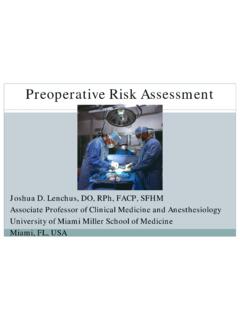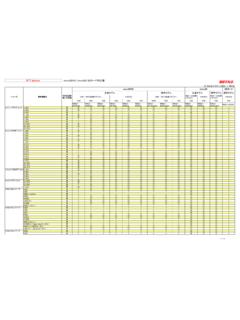Transcription of OMT in the Pregnant Patient - Florida Osteopathic Medical ...
1 OMT in the Pregnant Patient Tiffany Sayles Family Practice NMM/OMM +1 Resident Larkin Community Hospital September 18, 2015. Overview Osteopathic considerations Common pregnancy symptoms Physiological and biomechanical factors Somatic dysfunction Special considerations of the Pregnant Patient Osteopathic evaluation and treatment Osteopathic Considerations The body is a unit Interrelationship between structure and function The role of the physicians is to enhance the body's ability to heal itself Restoration of the body's maximal functional capacity enhances the level of wellness and assists in recovery from injury and disease. Common Pregnancy Symptoms Headache Nasal congestion Nausea/vomiting/Indigestion Dyspnea Back Pain Pelvic Pain Constipation Edema Physiological and Biomechanical Factors Hormonal influence hCG, progesterone, estrogen, aldosterone, cortisol, relaxin, oxytocin Increased cardiac output Increased blood volume Increased blood to lining of airways Decreased CO2 in blood Increased respiratory rate and decreased lung expansion Increased filtering by the kidneys Physiological and Biomechanical Factors Smooth muscle relaxation Breast enlargement and tenderness Uterine enlargement and protruding abdomen Decreased blood flow from LE and pelvis Increased gastric emptying time and water absorption.
2 Decreased sphincter tone and digestive tract motility Loosening and increased flexibility of joints and ligaments Physiological and Biomechanical Factors Physiological and Biomechanical Factors Thoracoabdominal Diaphragm Physiological and Biomechanical Factors Pelvic Diaphragm Physiological and Biomechanical Factors Physiological and Biomechanical Factors Physiological and Biomechanical Factors Common Pregnancy Symptoms Headache Nasal congestion Nausea/vomiting/Indigestion Dyspnea Back Pain Pelvic Pain Constipation Edema Gynecologic Viscerosomatic Reflexes Parasympathetics Increased tone = uterine relaxation and cervical constriction Vagus n., pelvic splanchnic n. C0-C2, S2-S4 colon S2-S4 female urogenital tract Sympathetics Increased tone = uterine constriction, cervical relaxation T9-L2 uterus, kidneys, ureters, bladder, colon T10-T11 ovaries T10-L2 fallopian tubes Somatic Dysfunction Postural changes Innominate Cranial strains dysfunctions Cervical dysfunctions Pubic shears Rib dysfunctions Sacral dysfunctions Diaphragm Dependent Edema Restrictions (thoracic Viscerosomatics and pelvic) TART.
3 Thoracolumbar dysfunctions Considerations of the Pregnant Patient H&P first. Rule out any red flags. The Pregnant pt. may not be able to lie prone comfortably. The Pregnant pt. may not be able to lie flat in the supine position. The Pregnant pt. may not be able to lie in the lateral recumbent position on their right side. Treat the pt. in the position of comfort. Indications Somatic dysfunction Chronic structural conditions prior to pregnancy Pregnancy associated conditions in which OMT can be used as and adjunct After trauma, organic causes, unexplained conditions and emergent issues are evaluated/ruled out. Pearls of Examining the Pregnant Patient Monitor gait wider stance, external rotation of hips, more contact with external border of foot, more weight bearing on hind foot tensions pull pubis apart Spinal A/P curves Evaluate for symmetry of bilateral landmarks Side bending and rotation pattern Assess for uterine wall and membranous tensions Evaluate uterosacral ligaments Pearls of Examining the Pregnant Patient Assess the transition areas OA, TL, LS (most stressed).
4 TART. Evaluate cervicothoracic inlet, ribs, diaphragm Palpate the sacrum, CRI, motion Evaluate for anterior counterstrain points, innominate and pubic dysfunctions Review of Common Pregnancy Symptoms Headache Nasal congestion Nausea/vomiting/Indigestion Dyspnea Back Pain Pelvic Pain Constipation Edema OMT. Headaches Occipital Release Pt. supine w/ Dr. at table head Dr. holds occiput in palms with fingertips inferior to the inion. Fingers are at a 90. degree angle with tips pressing in suboccipital muscles until a release is appreciated. OMT. Headaches Sacral-Sternal Release Pt. supine or in lateral recumbent Dr. places one hand on the sacrum and the other hand on the sternum Dr. moves fascia to assess and treat restrictions. OMT. Nausea/Vomiting/GERD. Chapman's Points Pt. in position of comfort Dr. palpates for tender Chapman points Dr uses either thumb or index finger to apply rotatory pressure into the tender point for 10-30.
5 Sec. OMT. Nausea/Vomiting/GERD. Subcostal Visceral Release Pt. lateral recumbent with Dr. standing behind pt. One hand contacting subcostally and the other over the lower rib cage. Dr. alternates hand movements and moves fascia to assess and treat restrictions. OMT. Dyspnea Thoracic Inlet Release Pt. supine w/ Dr. at head of table. Dr. hands are surrounding the inlet inferior to clavicles, monitoring for fascia tightness. Dr. moves fascia to assess and treat restrictions. OMT. Dyspnea Doming the Diaphragm Pt. is supine Dr. grasps the lower aspects of the pt's rib cage. Thumbs and thenar eminences are just below costal margins. Pt. inhales deeply while Dr. follows, exaggerating diaphragm and rib cage motion to treat restrictions. OMT. Back Pain Frog Leg Kick Myofascial Release Pt. supine w/ Dr. at the foot (coccyx). end of the bed. Pt. sitting w/ Dr. behind Pt. knees are flexed and Dr.
6 Palpates coccyx with externally rotated. Dr's one hand while inducing hand is on the sacral base lateral sidebending of the applying a caudal traction. spine. If coccyx does not Pt. kicks both legs quickly move to the same side as and forcefully to straighten the shoulders, + restriction. legs. Use sidebending to treat coccyx restrictions with MFR. OMT. Pelvic Pain Uterine Lift Pt. sitting, supine or standing and Dr. at side. Dr. places one hand under the uterus applying a gentle upward lift. The pt. moves and the Dr. assess for tension. Dr. can move fascia to aid release.. OMT. Pelvic Pain Balancing Still Technique (pubis). Pt. supine and Dr. at side. Pt. supine w/ Dr. at side. Dr. places one hand over Pt. bends leg on inguinal region and one dysfunctional side, other leg hand over the 12th rib/ straight. arcuate ligaments. Dr. abducts pt's hip while Disengage by compressing towards the compressing the tissues.
7 Pubic symphysis and then Exaggerate by taking the externally circumducts the tissue into the direction of hip. injury (dysfunction). Circumduction continues Balance tissue for release. until leg is back on the table OMT. Constipation Ischial Tuberosity Spread Pt. is in knee chest position. Dr. stands at the foot end of the table and internally rotate the pt's thighs. Dr. places pads of thumbs bilaterally upon the ischial tuberosities, applying firm and continuous lateral pressures. Ask pt. to cough Appreciate release. OMT. Edema Rib Raising Pt. supine or seated Dr. contacts the rib angles with fingertips of both hands. Gently push or pull the rib Rib Angles angles anteriorly for 20 sec or repetitively until rib mobility improves. Thank You Any Questions? References Chila, Anthony G., et. al. Foundations For Osteopathic Medicine, 3rd Ed. Baltimore: Lippincott Williams & Wilkins.
8 2011. Channell, MK, Mason DC. The 5-Minute Osteopathic Manipulative Medicine Consult. Baltimore, MD. Lippincott Williams and Wilkins. 2009. DeStefano, Lisa. Greenman's Principles of Manual Medicine, 4th Ed. Baltimore, MD: Lippincott Williams & Wilkins. 2011. Lavelle, JM. Osteopathic Manipulative Treatment in Pregnant Women. J Am Osteopath Assoc. 2012;112(6):343- 346. Nelson KE, Glonek T. Somatic Dysfunction in Osteopathic Family Medicine. 2 nd Ed. Baltimore, MD: Wolters Kluwer Health; 2015:127-141. Savarese, R. G., et. al. OMT Review- A Comprehensive Review In Osteopathic Medicine. Third Ed. 2003. Stone CA, Barral J-P, Kuchera ML. Visceral and Obstetric Osteopathy. Philadelphia, PA: Churchill Livingston Elsevier; 2007: 285-324. Steele KM, Essig-Beatty DR, Comeaux Z, Lemley WW. A Pocket Manual of OMT: Osteopathic Manipulative Treatment for Physicians. Baltimore, MD: Lippincott Williams and Wilkins.
9 2006.








